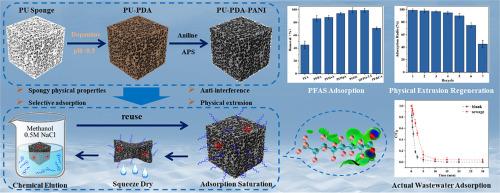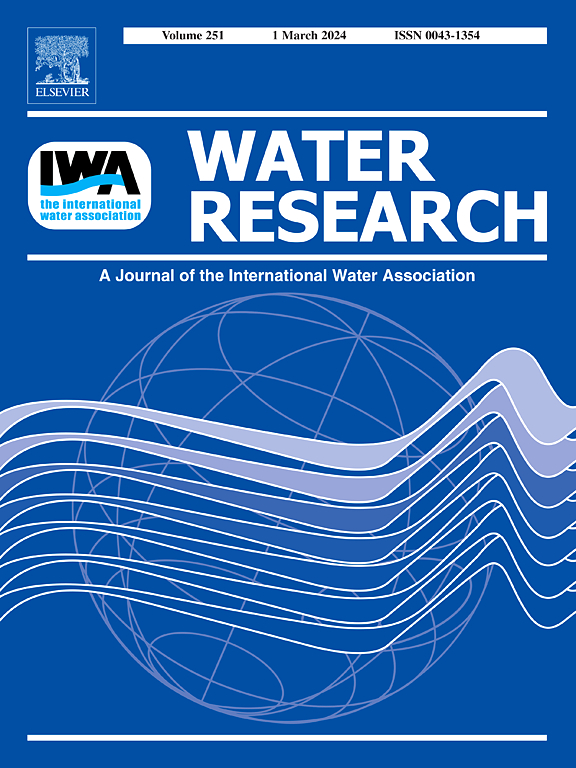Highly Efficient Removal of Per- and Polyfluoroalkyl Substances by Extrusion-regenerated Aminated Polyurethane Sponges
IF 11.4
1区 环境科学与生态学
Q1 ENGINEERING, ENVIRONMENTAL
引用次数: 0
Abstract
Per- and polyfluoroalkyl substances (PFAS) are a class of persistent organic compounds widely detected in the environments. Due to their chemical stability, physical adsorption has emerged as one of the most promising techniques for remediating PFAS-containing wastewater, while some newly synthesized functional absorbents in powder form suffer from separation issues. Inspired by mussel biology, we have successfully synthesized a porous spongy absorbent termed aminated polyurethane (PU-PDA-PANI) with over 99.5% removal efficiency for initial 10 mg L−1 perfluorooctanoic acid (PFOA), corresponding to the maximum adsorption capacity of 1.42 g g−1, which was superior to the ion exchange resin (Purolite® PFA694E, 0.764 g g−1). In addition to PFOA, PU-PDA-PANI also showed excellent removal efficiencies for other typical PFAS (i.e. perfluorooctane sulfonates, perfluorobutyric acid, perfluorooctane-1,8-dioic acid, hexafluoropropylene oxide trimer acid, etc), and the adsorption processes resistant to pH changes and co-existing environmental matrixes. Furthermore, PU-PDA-PANI can be readily reused and regenerated by coupling extrusion and elution procedures. The adsorption mechanism of electrostatic, hydrogen bond and hydrophobic synergistic interaction was further proposed with the support of theoretical calculation. In conclusion, this study develops an efficient and recyclable PFAS adsorbent and proposes some new insights for the design of PFAS-selective adsorbents.

挤出再生氨化聚氨酯海绵高效去除全氟烷基和多氟烷基物质
全氟和多氟烷基物质(PFAS)是一类广泛存在于环境中的持久性有机化合物。由于其化学稳定性,物理吸附已成为修复含pfas废水的最有前途的技术之一,而一些新合成的粉末状功能吸附剂存在分离问题。受贻贝生物学的启发,我们成功地合成了一种名为氨化聚氨酯(pu - ppa - pani)的多孔海绵吸附剂,对初始10 mg L−1的全氟辛酸(PFOA)的去除效率超过99.5%,对应的最大吸附量为1.42 g g−1,优于离子交换树脂(Purolite®PFA694E, 0.764 g g−1)。除PFOA外,PU-PDA-PANI对其他典型PFAS(即全氟辛烷磺酸盐、全氟丁酸、全氟辛烷-1,8-二酸、六氟环氧丙烷三聚酸等)也表现出优异的去除效率,并且吸附过程对pH变化和共存的环境基质具有抗性。此外,PU-PDA-PANI可以通过耦合挤压和洗脱过程很容易地重复使用和再生。在理论计算的支持下,进一步提出了静电、氢键和疏水协同作用的吸附机理。综上所述,本研究开发了一种高效、可回收的PFAS吸附剂,并为PFAS选择性吸附剂的设计提出了一些新的见解。
本文章由计算机程序翻译,如有差异,请以英文原文为准。
求助全文
约1分钟内获得全文
求助全文
来源期刊

Water Research
环境科学-工程:环境
CiteScore
20.80
自引率
9.40%
发文量
1307
审稿时长
38 days
期刊介绍:
Water Research, along with its open access companion journal Water Research X, serves as a platform for publishing original research papers covering various aspects of the science and technology related to the anthropogenic water cycle, water quality, and its management worldwide. The audience targeted by the journal comprises biologists, chemical engineers, chemists, civil engineers, environmental engineers, limnologists, and microbiologists. The scope of the journal include:
•Treatment processes for water and wastewaters (municipal, agricultural, industrial, and on-site treatment), including resource recovery and residuals management;
•Urban hydrology including sewer systems, stormwater management, and green infrastructure;
•Drinking water treatment and distribution;
•Potable and non-potable water reuse;
•Sanitation, public health, and risk assessment;
•Anaerobic digestion, solid and hazardous waste management, including source characterization and the effects and control of leachates and gaseous emissions;
•Contaminants (chemical, microbial, anthropogenic particles such as nanoparticles or microplastics) and related water quality sensing, monitoring, fate, and assessment;
•Anthropogenic impacts on inland, tidal, coastal and urban waters, focusing on surface and ground waters, and point and non-point sources of pollution;
•Environmental restoration, linked to surface water, groundwater and groundwater remediation;
•Analysis of the interfaces between sediments and water, and between water and atmosphere, focusing specifically on anthropogenic impacts;
•Mathematical modelling, systems analysis, machine learning, and beneficial use of big data related to the anthropogenic water cycle;
•Socio-economic, policy, and regulations studies.
 求助内容:
求助内容: 应助结果提醒方式:
应助结果提醒方式:


